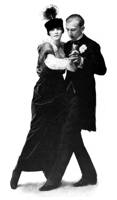
|
The Society of Folk Dance Historians (SFDH)
The Tango Family Tree
[
Home |
About |
Encyclopedia | CLICK AN IMAGE TO ENLARGE |

|

 The antecedents of the Tango are difficult to trace, but may include the African candombe ("an Uruguayan music and dance style"), or a Spanish tango, possibly of Romani origin, that may have been brought to Argentina by touring Zarzuela theatre companies. Or the Cuban Habanera ("dance of Havana"), an evolution from European social dances brought to Argentina by immigrants, or one of the many dances of the gauchos (the Gato, Chifras, Pericón, Chacarera, or Estillos). Or more likely, combinations of some of the above.
The antecedents of the Tango are difficult to trace, but may include the African candombe ("an Uruguayan music and dance style"), or a Spanish tango, possibly of Romani origin, that may have been brought to Argentina by touring Zarzuela theatre companies. Or the Cuban Habanera ("dance of Havana"), an evolution from European social dances brought to Argentina by immigrants, or one of the many dances of the gauchos (the Gato, Chifras, Pericón, Chacarera, or Estillos). Or more likely, combinations of some of the above.
The roots of tango are not known with certainty because it was created by the disenfranchised poor, who lived in the arrabales ("outskirts") of Buenos Aires. These barrios were primarily immigrant slums, that expanded with a migration from the pampas as farms failed or were taken over by the land barons. Free from the support or control of the city government, the surrounding arrabales developed their own unique subculture of the dispossessed, and it was here that the tango evolved. When a dance arises from a disenfranchised subculture, the roots are especially vague because these developments were rarely described by those in the inner city who could record events for posterity.
And finally, the origins of the Tango are not only blurred, but were often intentionally obscured by those who preferred a more respectable heritage, or more sensational imagery ("Born in the brothels!"), for the dance.
THE PARIS TANGOMANIA
The world first saw the tango when Argentine dancers brought it to Paris around 1910. It then became the biggest news in Paris – the 1912-15 Tangomania, which quickly spread to England, the United States, Germany, and throughout Europe. Dancers around the world fell in love with the Tango, and added it to their growing repertoire of social dances.
When we compare 1912-15 European and North American tango descriptions to Buenos Aires tango manuals from the same time, we see that the northern hemisphere dancers mostly got it right, dancing the same steps, in the same style, as the Argentines.
Don't believe that? Read on.
There are three main branches on the family tree of Tango.
1. Living Tradition Argentine (Tango Argentino)
This is Tango as danced in Buenos Aires today. Most social dance forms continue to evolve in their country of origin, and tango is the perfect example. Every decade has seen changes in steps, style, and music.
When we compare today's Argentine Tango to descriptions from Buenos Aires dance manuals a century ago, we see that the original combination of slow and quick steps has mostly disappeared from Tango Argentino today. A typical early Argentine timing was slow-slow-quick-quick-slow. Tango promenade position (both looking forward, side-by-side, clasping hands in front) was featured in early Buenos Aires tango manuals, and has also disappeared, along with other original elements. But these all remain in social ("American") Tango.
Other steps and styles have been added to Tango Argentino over the decades, like intricate footwork (ganchos, sacades, barridas, etc.). Many Tango Argentino groups now play remixed electro Tango music at their practicas ("practice sessions") and milongas ("excited habaneras, or Cuban Contradanza – a popular dance music genre of the 19th century), while others prefer Golden Age (1930s and 40s) music. Close embrace tango was introduced to this country in 1955 at the Stanford Tango Week, and has since been widely adopted. After many decades of changes, today's Argentine Tango is significantly different from the original version.
Living tradition tango Argentino is danced throughout the world today.
2. Social Tango
When the Tangomania hit during the "Ragtime Era," social dancers already knew many dances, including the one-step, waltz, two-step, the Maxixe from Brazil, and Foxtrot. So they enthusiastically added the Argentine Tango to their growing repertoire of dances.
Then as time went on, social dancers had no reason to change the tango. It wasn't broken, so why fix it? Therefore, today's social tango is essentially the continuation of the original Argentine tango. Yes, there have been a few evolutionary changes over time, but they're relatively minor, compared to the greater changes that have been made to the other two families of tango.
Ironically, some people call this American Style Tango. They use this term to differentiate if from International Style (British) tango, but it's nevertheless odd to call the nearly-unchanged original Argentine Tango "American" (unless one means South American).
Social tango is also the form of tango most often seen in movies, perhaps to advance a romantic relationship, or to add dramatic flair.
Since social Tango is essentially the original Argentine Tango, and the least changed of the three branches, it contains many of the fundamental foundation dynamics, upon which the other two forms are built.
Which one changed?
Today, most Argentines believe that Europeans changed ("tamed" or "corrupted" or "bastardized") the Argentine Tango, when in fact, it was the Argentines who changed it, while European and American social dancers kept it almost the same. I'm not implying that change is a bad thing – it's natural, and a sign of healthy growth. But maintaining an old tradition has its own value, so all forms of Tango are valid, each enjoyed by thousands of enthusiastic devotees.
3. Competition Ballroom Tango (International Style Tango)
The other reason why dances change is competitions. You won't win by being the same as your competitors – you need to add something extra to stand out. New steps are constantly created, as others are deemed out-of-date. For instance, the Champion competitor Fred Camp introduced a quick head snap from Germany to British ballroom tango in 1933. Somewhere along the line it was decided that the woman must look away from her partner.
Tango style then changed dramatically when the Elimination Round was introduced, in which the competition begins with a fairly crowded floor, filled with all of the competitors dancing at once. The judges thin the crowd down to a few finalists to be individually evaluated. The dancers have to perform far more expansive movements, to stand out from the crowd. Extreme, expanded movements are a matter of survival, either outshining the others, or being quickly eliminated. This expansiveness has become the look of competition-style Tango.
HISTORIC TANGO
In addition to the three branches of Tango commonly done today, many dance historians and vintage dancers enjoy learning the original tango from a century ago, reconstructed from dance manuals and films from the period. Early tango is popular at vintage dance weeks, both in the United States and Europe, and is re-enacted, in period attire, at vintage balls.
Other branches
Just as in human family trees, branches often cross-pollinate. For example, Finnish Tango can be seen as a hybrid of social Tango, Foxtrot, and Tango Argentino. The English Sequence Dance and Round Dance movements have short repeating tango choreographies, and can been seen as a three-way morph of social, competitive, and historic tango. Most of these sequences date back to the 1920s to 1950s, and the choreographies haven't changed since then. They are usually danced socially, not competitively. International folk dancers and Australian "bush dancers" still enjoy doing these sequenced Tangos, such as the Royal Empress Tango (1922).
Body contact in tango
This is an interesting comparison. We have many illustrations and photographs from the early years of tango in Argentina to know that there was originally little or no body contact between the dancers. The space between dancers varied, from barely touching to six inches (15 cm), but there was no compressure.
Social Tango and Argentine salon style Tango continue this distance between partners, as one would expect, since they changed the least. Close embrace Tango Argentino connects at the chest. International Style ballroom Tango connects at the pelvis.
Which one is best?
That depends on your personal preference. As mentioned, all of these forms are valid, enjoyed by thousands of enthusiastic devotees.
DOCUMENTS
- Allure of the Tango, an article.
- Argentine Tango, an article.
- Waltz, One Step, and Tango Partnering Tips, an article.
Used with permission of the author.
This page © 2018 by Ron Houston.
Please do not copy any part of this page without including this copyright notice.
Please do not copy small portions out of context.
Please do not copy large portions without permission from Ron Houston.